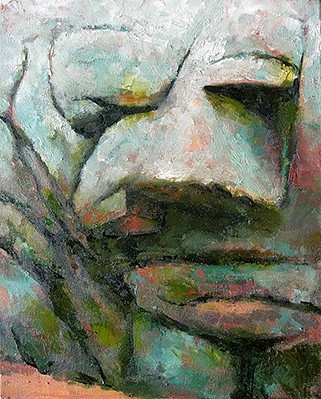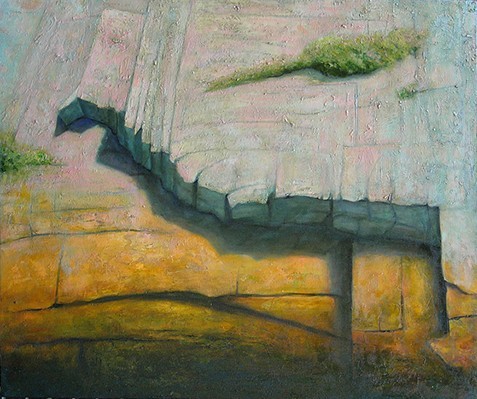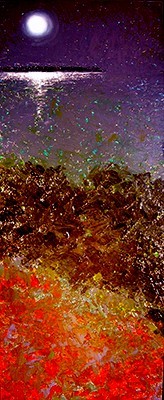Ken Beck Landscape Paintings at Gallery NAGA
Rock 'n Tree Mixes Beauty and Whimsy
By: Shawn Hill - Sep 11, 2008
Ken BeckRock 'n Tree
Gallery NAGA
September 2-27
67 Newbury St., Boston
http://www.galleryNAGA.com
Sometimes Ken Beck's sense of humor gets the best of him. There's a level of whimsy to many of these paintings that seems at odds with the stolid forms within. Beck's typical canvas shape is the square, and he usually fills those borders nearly to the edge with swollen, solid forms. In the past they've been fireplugs, other times more abstract cylinders or spheres. Jars full of honey, or smeared with mayonnaise or paint. Pears and apples that swell and bulge suggestively were long-time subject matter, as were stuffed teddy bears.
In this show the cylinders are the trunks of trees, and the swollen forms are large, weathered rocks. The overall landscape theme is an intriguing one for Beck and (according to gallery notes) one that begins with a nostalgic impulse. There are scenes of fall trees, vibrant leaves, and verdant marshes that speak to a life lived in New England's changeable seasons. Beck's mastery of his craft makes even minor studies of nature into sturdy constructions.
"Yellow Blaze" is just that, a shock of yellow leaves flaring wildly, framed by a forest of dark evergreens on a sloping bank. Against a blue sky. With a red earthen path below. Hardly something never seen before, but painted just on the verge of reality, the colors pushed slightly into Beck's own bright, high contrast palette.
"Below the Marsh" contrasts a serene field of green grass and blue sky to a riot of earthy browns painted in heavy impasto below: a subterranean vision of churning natural forces. "Up the Hill" has a lucid, light-flecked course of grass undulating in the distance, while up close an unnatural blur of turquoise wildflowers arrests our attention. These scenes, on narrow rectangular panels, clearly pick up on influences from Impressionist plein air painting and (influencing the Impressionists as well as Beck) the lovely simplicity of Asian landscape scrolls.
More typical of Beck is the human quality he finds in natural forms. A painting of curling birch bark resembles an abstracted face mask, and in two images of a rocky prominence Beck finds a playfully absurd face. "Big Rocky Face 1" and "2" are literally rockfaces, but in the earthen cracks and crevices one can see hints of nose, mouth, a patch of grass that becomes a quizzical eyebrow. You don't need to see this face to admire Beck's command of color and texture; but it's there if you squint, an added layer of interest.
There isn't as much humor in "Sea Bricks and Stone," a gorgeous study in the textures of four different rocks, resting in a square formation on a ropy, striated surface. This unusual still life is the sort of painting to remind us of the source of all of Beck's whimsy; even when he's working from nature, he never forgets that his illusions on flat surfaces depend on all that he can do with his oil-soaked brush. The fictional nature of his painting retains a winking self-awareness.




